Art Activity Video: Zandra Rhodes
Make sustainable textile art!
Activity best for children age 4 and up
Zandra Rhodes grew famous designing clothing for Diana, Princess of Wales, rock and movie stars, as well as lavish costumes for opera productions. Can you tell what Zandra’s favorite color is? Pink of course! Although she has had green, red, and other bright colors in her hair, pink is her favorite, and she uses it a lot in her textile design. Her travels all over the world have influenced her fashion and fabric designs, but the beautiful wild cliffs near one of her homes in La Jolla, California, with its wildflowers, are inspiring her designs now. She often picks plants and flowers she sees on walks with friends to take home to spark her imagination. Zandra doesn’t just get inspired by nature, she takes care of it!
Zandra Rhodes clothes are not just bright and beautiful, they are “zero waste fashion.” The fashion industry is the second largest landfill polluter in the world. Zandra helps inspire the clothing industry to use every part of the fabric in sewing, so nothing goes in the trash. Another thing she does is take old clothing, like a pair of jeans, and paints or prints on them with her beautiful nature inspired designs. What would you paint? Repurposing clothing, like a t-shirt or old pair of jeans, gives them a cool new look, and keeps them out of the trash!
Let’s make sustainable textile art inspired by Zandra Rhodes! Update your wardrobe and help the environment at the same time! Have your parents help you find something in your closet you can repurpose and paint.
Materials you’ll need (sharpie watercolor technique):
An old piece of light colored clothing, pillowcase, bucket hat, or tennis shoes you have permission to use
91% rubbing alcohol
Q-tips or small paint brushes
Bowl
Cardboard place between the front and back of clothing
Sharpies
Materials you’ll need (hand-painted acrylic technique):
An old piece of clothing, pillowcase, bucket hat or tennis shoes you have permission to use.
Acrylic craft paint
Mod Podge acrylic glue and sealer
Q-tips or small brushes
Bowl with water
Paper towels to place between the front and back of clothing and for clean up
Black Sharpie
Directions for Sharpie Watercolor Technique
STEP 1
Place Cardboard between layers of clothing or pillowcase to absorb and block ink from bleeding to the unpainted side. Assemble your color palette in a rainbow of cool and warm colors. Draw an image on the fabric with a pencil first.
Tips: This project requires parental supervision and is a great time to work outside and be inspired by nature and use ventilation provided by her. The combination of the 91% alcohol and Sharpie is a strong scent for some people. Ventilate! Wear old clothes to paint in or cover “good clothing” against accidental staining.
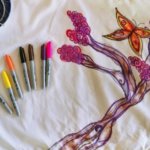
STEP 2
Draw on fabric with Sharpies! Keep lots of uncolored space–no need to fill every inch of drawing with color. The alcohol painting will fill the fabric with transparent “watercolor-like” color in the next step.
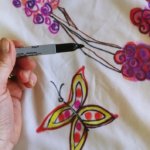
STEP 3
Paint the lines with Alcohol. No need to over saturate the fabric! The color will run–that is part of the process. Using small brushes or q-tips, keep the fabric from getting too wet.
Tip: Keep warm colors and cool colors separate if you are not familiar with color mixing. Colors that do not mix well are: Yellow and Purple, Blue and Orange, Red and Green.
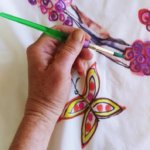
STEP 4
Add color and redefine lines as needed! You can use your Sharpies to add more color and draw over and add lines as you like. This is an open ended and “Happy Accident” way to paint! Your repurposed fashion artwork can be washed and worn once dry.
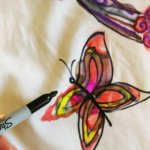
Directions for Hand-Painted Acrylic Technique
STEP 1
Place paper towels between layers of clothing or pillowcase to absorb and block ink from bleeding to the unpainted side. Assemble your color palette in a rainbow of cool and warm colors. You can draw your image on the fabric with a pencil first. Outline with Sharpie if you are working on denim or darker fabric.
Tip: This project requires parental supervision! Grab an old t-shirt and join in the fun. Wear old clothes to paint in or cover “good clothing” against accidental staining.
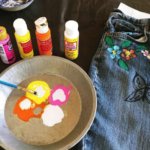
STEP 2
Mix Mod Podge Sealer into your paint tray.
Tip: Using cotton or silk fabrics allows for the best long term wearability. Fabrics that are higher in synthetic content or spandex don’t absorb the paint as readily.
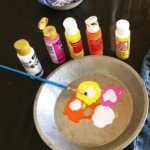
STEP 3
Paint the design with a brush or Q-tips. Encourage the children to keep their brushes clean and change water in tray frequently to keep colors from appearing muddy.
Tip: This is a great time to let kids “practice paint” a piece of fabric before they work on something you may want to keep! Keep warm colors and cool colors separate if you are not familiar with color mixing. Colors that do not mix well are: Yellow and Purple, Blue and Orange, Red and Green.
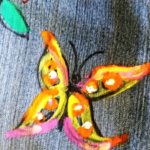
STEP 4
Add color and redefine lines as needed! You can use your Sharpies to add more color and draw over and add lines as you like. This is an open ended and “Happy Accident” way to paint! Your artwork can be washed and worn once dry.
Share your new clothes with us on Instagram by tagging @sdcdm320!
Questions about this activity? Email education@sdcdm.org

